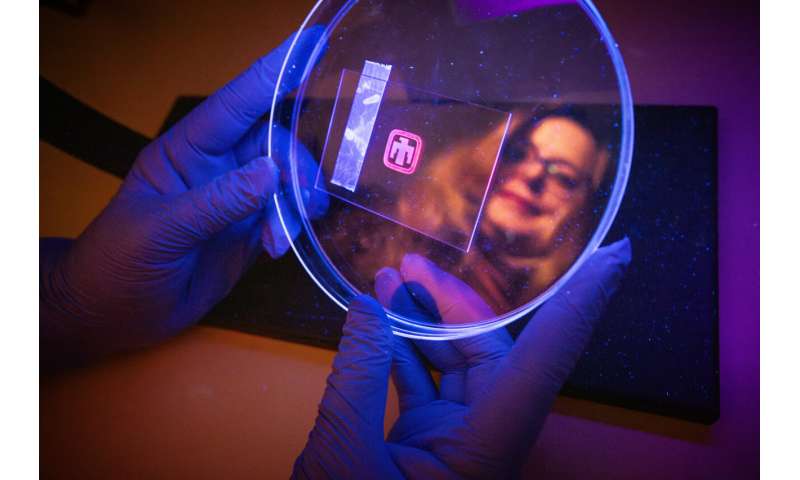High-tech invisible ink spells trouble for counterfeiters

A high-tech invisible ink invented at Sandia National Laboratories could become the newest tool for stopping counterfeit goods. The research team is now seeking partnerships to help develop and ultimately commercialize the new technology.
Beyond their negative economic impact, counterfeit goods can threaten public health. In 2022, the U.S. Drug Enforcement Administration seized more than 58.4 million fentanyl-laced fake pills. Six out of 10 pills the administration tested contained potentially lethal doses of fentanyl, according to its website.
This year, fentanyl-laced medicine was reported to have been sold in some northern Mexican pharmacies.
Sandia's inks offer a new way to mark authentic pill bottles and other goods, which could help legitimate companies get ahead of fraudsters and keep consumers safe.
"The development of new technologies that can effectively ensure asset safety and security, as well as integrity-checking throughout a product's lifecycle in this ever-evolving landscape, is critical," said materials scientist Dorina Sava Gallis, who leads the research.
New inks reveal sophisticated patterns under certain light
Sava Gallis' team invented a transparent material that, like invisible ink, can mark authentic goods with a special pattern or signature that only emerges under certain kinds of light. A light-sensitive marking is also called an optical tag.
The difference is that Sandia's high-tech inks have complex signatures that are difficult to imitate or reverse-engineer.
For example, shining an ultraviolet light on a Sandia-designed ink might cause one pattern to become visible, while also revealing a second, hidden pattern that can only be seen with an infrared camera. The patterns can even morph, revealing a signature animation instead of a static image.
After publishing their research on the materials development in several major scientific journals, including Angewandte Chemie, ACS Applied Materials & Interfaces and Nature Communications, the Sandia team is now seeking partners to help make it a commercial product. Several patent applications have been filed.
Research has been funded by Sandia's Laboratory Directed Research and Development program. The work was performed, in part, at the Center for Integrated Nanotechnologies, a scientific user facility operated by Sandia and Los Alamos national laboratories for the Department of Energy's Office of Science.
Hard-to-counterfeit inks created by positioning atoms with exactness
To create and test the new inks, Sava Gallis leads a team of control freaks in the best sense of the words. With world-class precision, they move atoms into exact positions in materials called metal-organic frameworks. This precision enables them to tailor exactly how long, how bright and what colors their materials shine under different conditions.
Lauren Rohwer, an expert in luminescent materials, studied how the ratios of the various light-emitting metal ions in the new inks affect how long it takes for their photoluminescent signatures to fade. The timing is important for designing dynamic signatures.
"In this work, the lifetime measurements, sometimes referred to as decay time measurements, involve exciting the sample with short pulses of ultraviolet laser light and recording the resulting photoluminescence as a function of time," Rohwer said.
Only the right amounts of certain metals placed in the proper atomic arrangement and ratios will produce a given image. With such particular recipes, Sava Gallis said, Sandia's optical tags can be authenticated in at least three distinct ways: detecting the signature under light, measuring how that signature changes with time and analyzing the chemicals that make up the ink.
"We are pushing the boundaries of made-to-order materials and how much complexity we can encode," she said.
Potential uses in medical industry, national security
The team is exploring more potential uses for their optical tags.
"One of my major interests is the intersection of materials and biology, and how we use materials to enhance biosafety," said Kim Butler, an expert in nanomaterials sensing and imaging on the team. "Counterfeit medicines and vaccines, as well as medical devices and food additives, can have a major impact on health and are a growing problem."
Hard-to-counterfeit tags provide a method to authenticate these, as well as other items.
Butler helped study an additional sensor component on optical tags to indicate if temperature-sensitive packages were mishandled during shipment. Combining multifactor authentication with information on shipping conditions could be applied to many areas but would be particularly important in the medical field. Certain vaccines, for instance, have to be kept cold.
"This would be an additional signature that would not compromise the tag features but would turn on if the temperature was too high during shipment," Butler said.
Sandia has a long history of developing anti-tamper and anti-counterfeit technologies, with work related to treaty verification dating back to the 1980s. Advanced tags and seals invented at the labs have been used to help ensure compliance with international treaties that limit nuclear weapons by ensuring monitored items, such as containers of spent nuclear fuel, are not diverted by a state to establish a clandestine nuclear weapons program.
Although not funded under the same program, Sandia's new optical tags could potentially help nuclear inspectors ensure the safeguards and security of radiological materials or protect vital national security assets from being infiltrated with fraudulent or tampered components.
Researchers and organizations interested in partnering with Sandia National Laboratories in the development of metal-organic framework optical tags are invited to visit sandia.gov/working-with-sandia or email partnerships@sandia.gov for more information.
More information:
Jacob I. Deneff et al, Encoding Multilayer Complexity in Anti‐Counterfeiting Heterometallic MOF‐Based Optical Tags, Angewandte Chemie International Edition (2020). DOI: 10.1002/anie.202013012
Dorina F. Sava Gallis et al, Programmable Photoluminescence via Intrinsic and DNA–Fluorophore Association in a Mixed Cluster Heterometallic MOF, ACS Applied Materials & Interfaces (2022). DOI: 10.1021/acsami.1c24477
Jacob I. Deneff et al, Orthogonal luminescence lifetime encoding by intermetallic energy transfer in heterometallic rare-earth MOFs, Nature Communications (2023). DOI: 10.1038/s41467-023-36576-z
Provided by Sandia National Laboratories